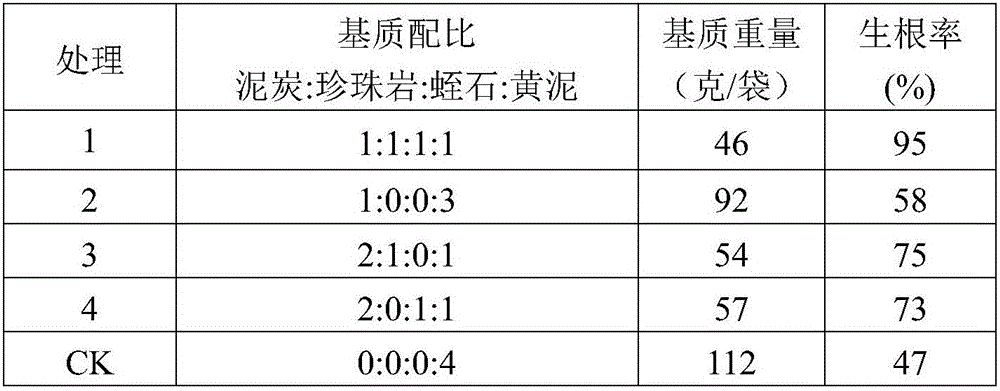Method for culturing Chinese fir cuttage container seedlings through light medium
A cutting container and cultivation method technology, applied in the field of forest cultivation, can solve problems such as unfavorable clonal seedling production or production cost, low reproductive coefficient per unit mother tree, seedling death, etc., and achieve excellent growth vigor of container seedlings and utilization of cuttings and fringes. The effect of high rate and stable inheritance of traits
- Summary
- Abstract
- Description
- Claims
- Application Information
AI Technical Summary
Problems solved by technology
Method used
Image
Examples
Embodiment 1
[0021] From mid-June to early July, select healthy and disease-free sprouts with a length of 8-12 cm and a thickness of more than 0.4 cm to make cuttings with terminal buds with a length of 4-7 cm and retain a few leaves. The cuttings are treated with hormones and then cut into light substrates. Net bag, the substrate is peat: perlite: vermiculite: yellow mud = 1:1:1:1, the net bag is a 9cm*13cm non-woven bag with no bottom and no side, and the cutting depth is 2 / 3 of the length of the cuttings After planting, pour water thoroughly, cover and seal with shed film to keep moisture, and control the outside air temperature below 30°C through ventilation, mist spray and other means. After 21 days and 28 days, the rooting rate was counted, as shown in Table 1.
[0022] Table 1 Cutting Rooting Conditions Treated with Different Hormones
[0023]
[0024]
[0025] Remarks: The cutting hormone treatment time is 30s.
[0026] It can be seen from Table 1 that the 21-day and 28-day...
Embodiment 2
[0028] From mid-June to early July, select healthy and disease-free sprouts with a length of 8-12cm and a thickness of more than 0.4cm to make cuttings with terminal buds with a length of 4-7cm and retain a few leaves. The cuttings are dipped in 500ppm IBA solution at a medium speed Cuttings are then cut into different substrates. The depth of cuttings is 2 / 3 of the length of cuttings. After cuttings, water them thoroughly, cover and seal them with shed film to keep moisture, and control the outside air temperature below 30°C by means of ventilation and mist spraying. After 25 days, the rooting rate was counted, as shown in Table 2.
[0029] Table 2 Rooting situation of cuttings in different substrates
[0030]
[0031] Remarks: 1. After the matrix is configured according to the volume ratio, it is divided into light matrix containers. The container is a 9cm*13cm bottomless and sideless flat-mouth non-woven bag.
[0032] 2. Substrate weight is dry weight.
[0033] As ca...
Embodiment 3
[0035] Remove the film from the cuttage seedlings that have taken root and survive in Example 2, and cultivate them for 10 to 15 days under a shade shed with a light transmittance of about 50% and a humidity of more than 80%, and increase the light transmittance to about 75%. In summer, 10:00- 16:00 Keep regular mist spray to cool down and moisturize. Start to add quick-acting fertilizer 15 days after the film is removed, and the rest are cultivated according to conventional container seedlings. At the end of December of that year, the seedling height and ground diameter of the cutting container seedlings were measured and counted.
[0036] During the cultivation of fir, due to the high temperature in summer, a large amount of spraying is required to cool down, so that the water supply is sufficient, and the cultivation substrate is required to have good water permeability, otherwise the seedlings will turn yellow or even die due to water accumulation in the container. Due to...
PUM
 Login to View More
Login to View More Abstract
Description
Claims
Application Information
 Login to View More
Login to View More - R&D
- Intellectual Property
- Life Sciences
- Materials
- Tech Scout
- Unparalleled Data Quality
- Higher Quality Content
- 60% Fewer Hallucinations
Browse by: Latest US Patents, China's latest patents, Technical Efficacy Thesaurus, Application Domain, Technology Topic, Popular Technical Reports.
© 2025 PatSnap. All rights reserved.Legal|Privacy policy|Modern Slavery Act Transparency Statement|Sitemap|About US| Contact US: help@patsnap.com



